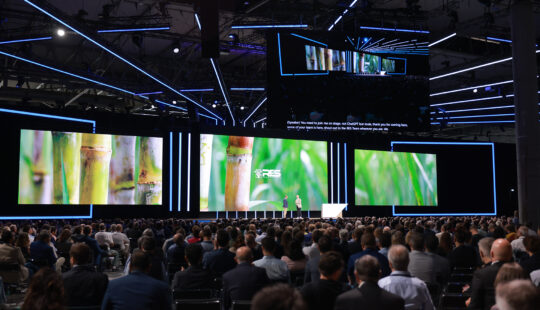Beyond the headline-grabbing news about a pandemic, trade barriers, and accelerated online purchasing, many forces are increasing pressure on supply chains. Over the past year, I’ve had many conversations with business leaders about their supply chain challenges.
Like many business leaders today, I’m seeing supply chain pressures moving from being behind-the-scenes issues to becoming front and center — discussed in board rooms and living rooms.
Resilient and sustainable digital supply chains have become the crucial differentiator for business. And with that, businesses are realizing they need to optimize end-to-end business processes along their entire value chain. They are recognizing that the customer experience doesn’t stop with the purchasing experience; in fact, the supply chain has become a significant driver of the customer experience. Companies can increase customer experience and satisfaction by more than 82% when they run highly resilient supply chains.
So, today’s businesses are striving for four key capabilities when it comes to their digital supply chains.
Agility Through Synchronized Planning
Now more than ever, businesses need visibility into events as they are happening to be able to sense, predict, and respond to inevitable disruptions. This is all about anticipating and mitigating events before they impact operations. That’s agility!
Synchronized planning is the key ingredient for agility. At SAP, we envision planning as a continuum across the supply and demand network — from production to logistics planning. Getting a complete view of their supply chains and evaluating the impact of one stage on another is what our customers are after. It’s what they need to mitigate risks.
Synchronized planning leads to synchronized execution. That’s the ability to execute smoothly from order to final delivery that every business is after. Our solutions combine scenario-based planning with synchronized execution, because without synchronized planning, agility remains elusive for businesses. And that’s what SAP is uniquely positioned to cover end to end.
Productivity Through Intelligent and Predictive Technologies
Businesses also achieve more when their plant and factory processes become smarter, more connected, and more autonomous, and when their people are empowered to employ those processes intelligently. The core of our mandate is enabling factory and plant transformation at enterprise scale.
Reinventing production, intra-logistics, quality, maintenance, and service processes is key here. We employ SAP HANA natively to deliver new scenarios, which were previously difficult to achieve, while also simplifying the application and data model. Intelligent and predictive technologies combined with edge computing and cloud capabilities can boost productivity.
We are helping thousands of companies reinvent production. And we are doing it by creating a single digital thread for products and assets — from the design in an engineering department to production on the shop floor and finally maintenance and service operations — and all along the way until an asset is sunset.
Partnership across our ecosystem is key to making that happen. We are proud to be partnering with leaders like Microsoft and Siemens. With Microsoft, we are collaborating to make SAP solutions available on Microsoft Azure Stack Edge, starting with SAP Digital Manufacturing Cloud. That’s how we combine edge computing on the shop floor with intelligent factory and plant processes in the cloud. That enables businesses to run even their mission-critical processes with high availability. That’s an innovation leap for all manufacturing industries.
Also, by teaming up with Siemens, we’re putting our customer on a faster path to creating an end-to-end digital thread. Last year, we added Siemens’ Teamcenter to our product lifecycle management (PLM) portfolio. Now, we’re taking the next step and complementing the Siemens solution portfolio with SAP Asset Intelligence Network, SAP Asset Strategy and Performance Management, and SAP Enterprise Portfolio and Project Management.
Networked Collaboration Through the World’s Most Intelligent B2B Network
Creating smarter inter-company visibility and collaboration is just a start. Extending that beyond a single enterprise is where the real magic happens. But many companies are hindered by enterprise-centric systems that are not designed for cross-company transparency and collaboration. That blunts their ability to drive change fast. That’s why we see the need to move beyond organization-centric and toward network-based approaches. Our solutions transform fragmented supply chains into agile, collaborative networks for supply, logistics, asset management, and service. They provide visibility and intelligence across networks for digital threads of assets, materials, and finished goods.
On our path to delivering SAP Business Network, we recently introduced our new trading partner portal. Buyers and suppliers can collaborate using shared data and workflows and leverage network-wide intelligence to make decisions. Because when all networks become one network, collaboration becomes synchronous.
Sustainability Through Circularity and Climate Action
End-to-end processes extend beyond a company’s own four walls, and so do the CO2 emissions they generate. Businesses face demands from all stakeholders to minimize waste, emissions, and energy consumption, and to reduce their carbon footprint by running sustainable business operations. With our new product, SAP Product Footprint Management, we’re enabling customers to evaluate and assess their carbon footprints across their end-to-end business processes and even across companies and industries.
However, the link between resource reuse and CO2 emissions is only becoming clearer: 45% of CO2 emissions can be eliminated by transforming the way goods are made and used. So, the path to a low-carbon future is circular, as I recently wrote. To achieve circularity, we must connect linear, fragmented supply chains into unified, collaborative, and intelligent business networks. One company’s waste can be a valuable resource for another. With our profound knowledge of business process software, and second new sustainability product, SAP Responsible Design and Production, we can identify those opportunities.
Collaborating with business partners has never been more important – and perhaps more fraught. So, in this time of intense disruption, I’m proud to be able to talk to business leaders concretely about how our solutions help build resilient supply chains and how our scale enables sustainable transformation in a networked economy.
These are just some of the key innovations we have introduced at SAPPHIRE NOW in 2021 and we have many more to come. Check out the SAPPHIRE NOW Innovation News Guide for more.
Thomas Saueressig is a member of the Executive Board of SAP SE, Product Engineering.
This story was originally published on LinkedIn.



